ID Challenge: Cooper’s Hawk vs Sharp-Shinned Hawk
Updated: Nov. 03, 2022
A common backyard birding challenge is learning how to ID a Cooper's hawk vs a sharp-shinned hawk. Look closely at these birds of prey.
Cooper’s Hawk vs Sharp-Shinned Hawk

Identifying backyard hawks can be quite the challenge. So many times they are just a blur of a bird quickly making a pass through your feeding station in pursuit of a meal. If you do happen to get a decent look at the hawk, or if it decides to perch in the open long enough for you to study it, you can likely identify the species. Here are some key features to look for when trying to tell the difference between a cooper’s hawk vs a sharp-shinned hawk.
How to Identify a Cooper’s Hawk
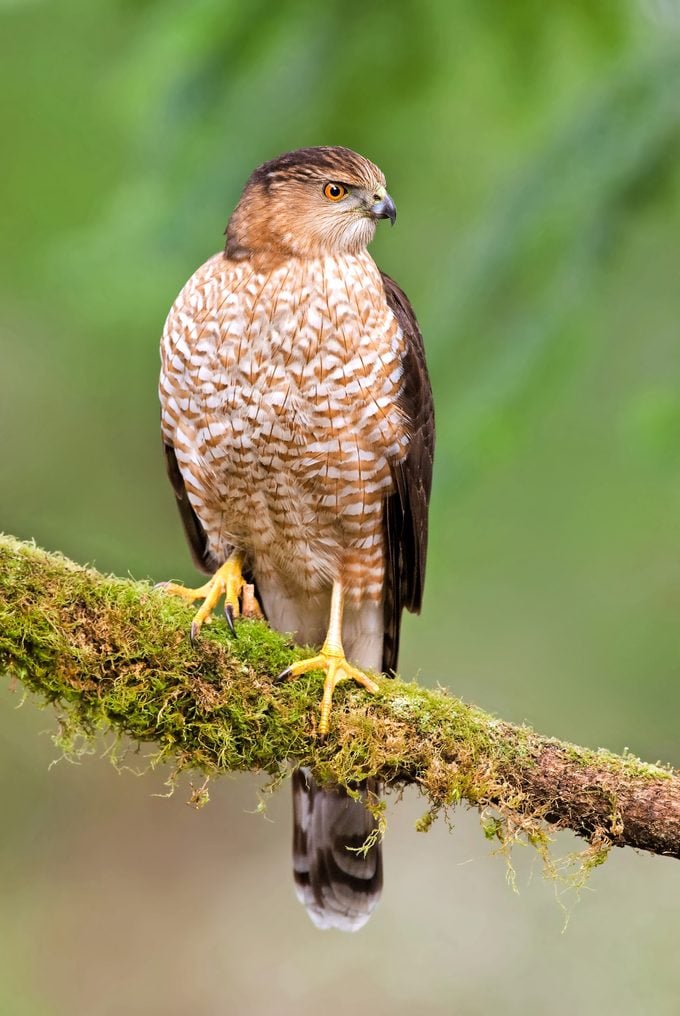
The Cooper’s hawk is a member of the accipiter group. It has relatively short wings—reaching only to the base of the tail—and a long tail that is broadly rounded at the tip. Adults Cooper’s hawks are blue-gray above and pale reddish on the chest. For about their first year of life, the young birds are brown, with dark stripes on a white chest.
The most similar bird would be the sharp-shinned hawk, but that’s a smaller species with a more square-tipped tail and a smaller head. The sharpie also has pencil-thin legs, not like the strong, robust legs on the Cooper’s. A young Cooper’s hawk looks similar to a young sharp-shinned hawk, but has a bigger head and stripes on the chest that are usually narrower, darker and more sharply defined.
Cooper’s hawks are curious, alert birds that often visit cities and towns, where they investigate yards and perch close to houses. Male Cooper’s hawks are significantly smaller than their female mates.
Here’s why crows chase hawks.
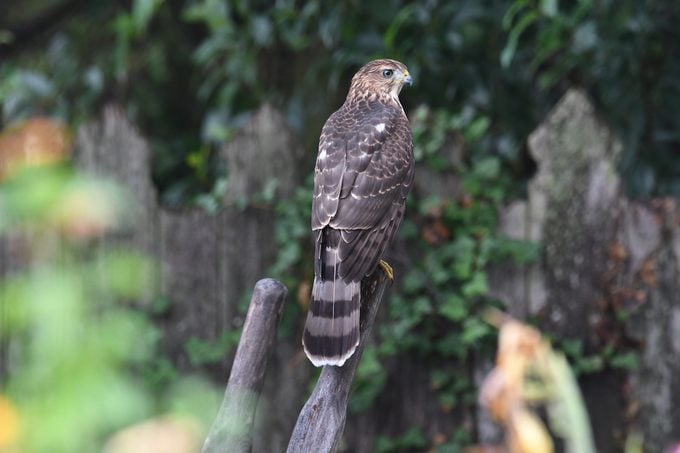
- Head Size: Proportional head that’s easy to see in flight.
- Head Color: Dark cap with lighter coloring on the neck.
- Legs: Thicker with a shorter appearance.
- Tail: The tail is long and slender. Tail feathers create a rounded look, with middle ones longer than the outer ones.
- Range: Cooper’s hawks occur throughout the continental United States during most of the year. They are a very common sight in many backyards and have adapted very nicely to hunting for prey at bird feeders. In general, if you have bird feeders, you’ve probably had this species in your yard.
Learn more about lesser-known raptors and birds of prey.
How to Identify a Sharp-Shinned Hawk
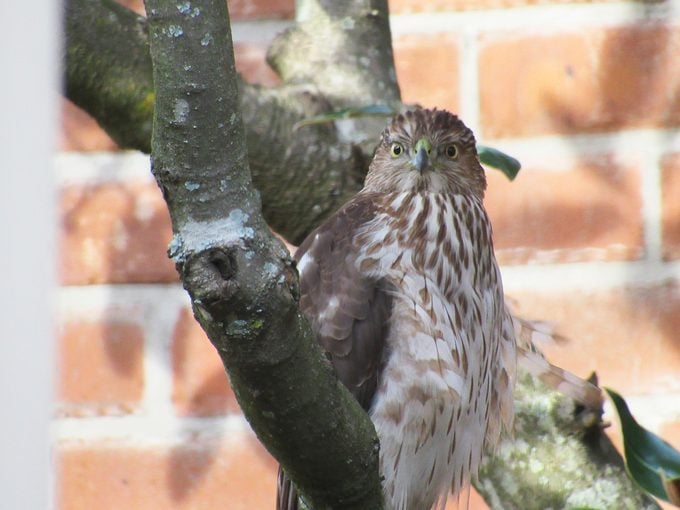
“An eerie silence fell over the usual bird chatter in my yard. Then I saw this hawk (above). What kind is it?” asks Pam Welsh, Baton Rouge, Louisiana.
The silence of your songbirds is understandable. The slim shape, short wings and long tail indicate that this is a member of the accipiter group of hawks, known for catching small birds. This one is a juvenile sharp-shinned hawk, the smallest accipiter in North America. Young sharp-shinned hawks are very similar to young Cooper’s, but their dark stripes below tend to be wider, more blurry and more reddish brown. Adults of either species would have blue-gray backs and horizontal reddish bars on the chest.
Here’s how to identify a red-tailed hawk.
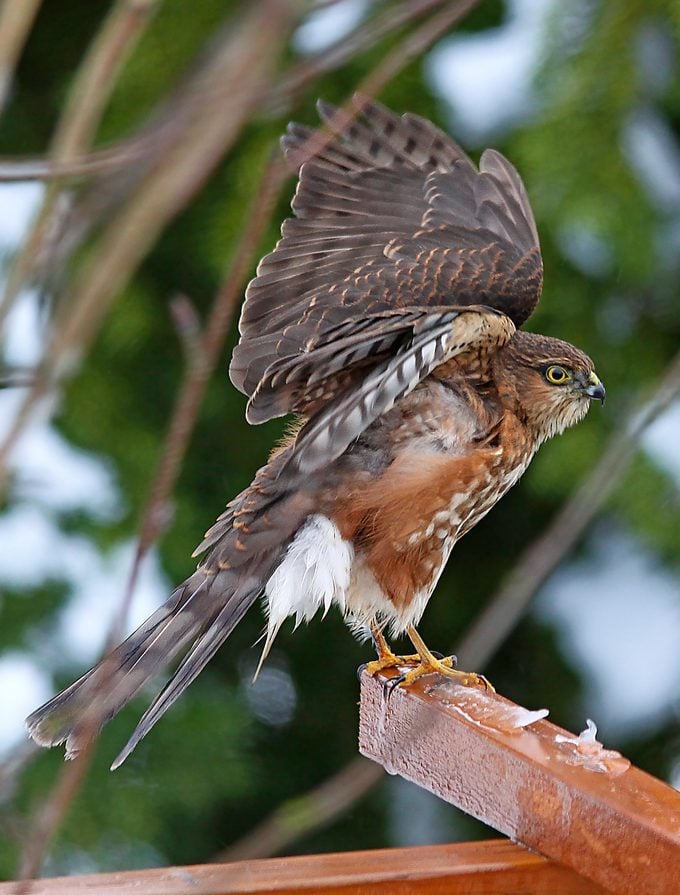
“What type of hawk is this (above)?” asks Birds & Blooms reader Peter Hoffman.
The Kaufmans write, “The relatively long tail and short wings indicate one of the accipiter hawks. Its yellow eyes, stripes on the chest and brown edges on some of the wing feathers show that it’s a young bird. Sharp-shinned and Cooper’s hawks can be very hard to tell apart, but several things mark this bird as a sharp-shinned. The chest stripes are reddish brown and blurry and the legs look pencil thin. The big-eyed look is also helpful. A Cooper’s hawk has a relatively larger head, so its eyes seem smaller, giving it a different facial expression.
Meet 9 types of hawks you should know.
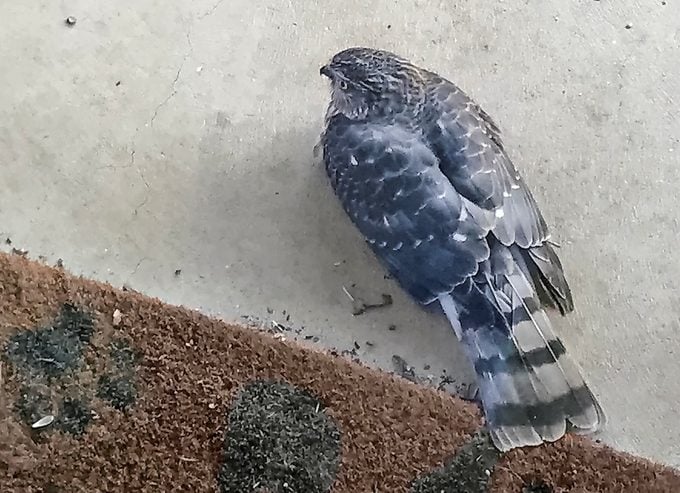
The sharp-shinned hawk is amazingly strong for its size. Although the sharp shinned isn’t much bigger than a blue jay or mourning dove, it’s a powerful little predator, pursuing prey in rapid bursts of flight. Recognizable field marks include a small but deeply hooked bill, and black bands across a gray square-tipped tail.
- Head Size: Smaller, more rounded head that barely sticks out when in flight.
- Head Color: Gray beginning on top of the head and continuing down through the neck feathers.
- Legs: Long and very thin.
- Tail: More square and uniform.
- Range: Sharp-shinned hawks occur farther north vs Cooper’s hawks. They stay year-round in parts of the Northwest and the Northeast, and are seen in most of the U.S. during the non-breeding season. This species is more commonly seen during migration or hunting at bird feeders during the winter months. They prefer dense cover and are less likely to perch in the open.
Next, learn how to tell the difference between bald eagles vs golden eagles. Or take on another ID challenge — house wren vs. a Carolina wren.




















